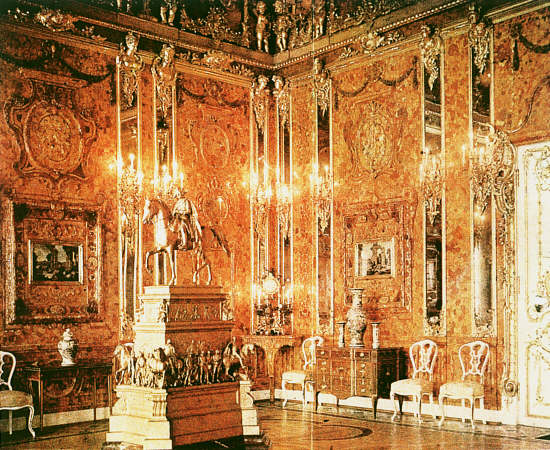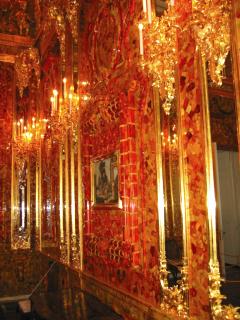The Amber Room is considered to be one of the greatest art works ever made and one of the biggest unsolved mysteries of the second world war.
It consists of nearly a hundred thousand panels, each created from Baltic amber resin infused with honey, linseed and cognac and then backed with gold and silver and accented with diamonds, emeralds, jade, onyx and rubies. In all, it has a total surface area of nine hundred and twenty-six square feet with amber being, at the time of its manufacture, twelve times more valuable than gold.

The room was first commissioned by Frederick I of Prussia in 1701, and then gifted to Peter the Great of Russia in 1716, although it wasn’t until Elisabeth Ist started reigning in the 1740s that the room was actually unpacked and first assembled in the Winter Palace.
In 1755, the Amber Room was transferred to the Catherine Palace in Tsarskoje Selo where it was re-assembled, although there were only enough panels to cover three walls. The remaining panels were completed over the next 15 years, with the room finally completed in 1770.
At the beginning of the second world war, the Russians deemed the Amber Room to be too fragile to move, and disguised it instead under a layer of hessian and wallpaper. The Nazis were not to be fooled however, and they discovered the room almost immediately when they occupied the palace in September 1941. Claiming the room as a German cultural treasure, they shipped it back to Königsberg Castle where they placed it on display.
Then, in August 1944, a British bombing raid hit the castle. The Nazis dismantled the room as a precautionary measure. The last known sighting of the room was in the Knight’s Hall where it had been packed into crates. It has not been seen since.

The disapearance of the Amber Room has triggered one of the longest running treasure hunts in history, and a succession of conspiracy theories as to its current location which range from an abandoned silver mine in Thuringia and the bottom of a lagoon in Lithuania.
The latest historical research suggests, however, that the room was in fact accidentally burnt by Soviet troops when they set fire to Königsberg Castle in April 1945. The Kremlin is believed to have subsequently covered this up and instead propgated the myth of the Amber Room’s survival as a negotiating tactic with the German government over the return of stolen wartime art and artefacts.
Today, after a multi-million dollar, twenty year effort, the Amber Room has been faithfully recreated in the Catherine Palace. Partly funded by a German energy company, it was completed in time to mark St Petersburg’s tercentenary in 2003.
In 1997, the son of one of the German officers who had accompanied the wartime convoy from St Petersburg to Königsberg was arrested for trying to sell a small section of the room. Although it is not known how the officer got it, this fragment remains, along with an intricately inlaid chest, the only part of the original Amber Room known to have survived the war.




